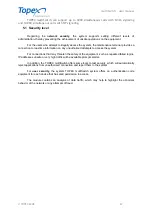
multiSwitch – user manual
© TOPEX 2008 23
Call hunting
– when a call is directed to certain user and this one can not answer, the call will be
forwarded to another user. If also the second user is busy, the call is routed to a third user. The order
of routing the calls is established depending on the “
Call hunting priority
” parameter.
0
Warning
: To accomplish the hunting operation, the users must be in the same hunting group!
Call pick up
– when a phone rings and the user is not there or he can not answer, another user can
take over the respective call. The user which wants to answer the calls must dial a code from his
terminal to take over the call. Then the first phone will stop to ring and the call is answered by the
second user.
0
Warning
: To accomplish the pick up operation, the two users must be in the same pick up group!
Voice mail
– the service that sends voice messages to a specified mail address. These messages
appear when:
•
destination is busy
•
destination not answers
•
destination is not available – the user is not registered
•
combination of all these options
Video
– allows the achievement of the video calls
Messages
– allows sending messages such as: “On Line”, “Busy”, “Be Right Back”, “Away”, “On the
phone”, “Out to lunch” or “Appear offline”.
4.3.4 FXS users
The FXS users are the usual analogical subscribers. The parameters of these users are
detailed below:
ANI
– the ANI code of the subscriber;
Client id
– the identification code for a client from the clients table;
Has allow in
– option which establish the clients who can call a certain client;
Has deny in
– option which establish the clients who can not call this client;
Call forward
- this option allows the forwarding of a call when the user can not answer and he
chooses a specified destination to answer the respective call. The options for using this service are the
same with those for the SIP users;
Voice mail
– the service that sends voice messages to a specified mail address. The cases for
messages appearance are the same with those for the SIP users;
Call hunting priority
- it is used to establish the priority to route a call from a busy destination to
another one. The algorithm must be a non linear one to avoid overcharging of a certain user. In the
case of a linear algorithm, when the destination number is busy, the call will be routed always to the
same user which will be overwhelmed;
Call hunting
– when a call is directed to certain user and this one can not answer, the call will be
forwarded to another user. If also the second user is busy, the call is routed to a third user. The order
of routing the calls is establish depending on the “
Call hunting priority
” parameter;
0
Warning
: To accomplish the hunting operation, the users must be in the same hunting group!
Call pick up
– when a phone rings and the user is not there or he can not answer, another user can
take over the respective call. The user which wants to answer the calls must dial a code from his
terminal to take over the call. Then the first phone will stop to ring and the call is answered by the
second user;
0
Warning
: It is necessary that the two users to be in the same pick up group to realize the pick up
operation!
Call state
– the status of the call which can be:
•
idle;
•
dialing;
•
alerting;
•
ringing;
















































